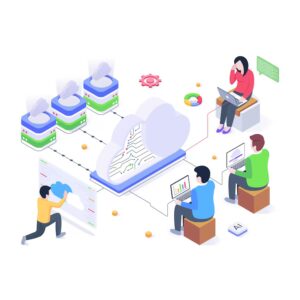Home Case Study Enhancing Data Processing Efficiency through Cloud-Based Solutions
Technology
Enhancing Data Processing Efficiency through Cloud-Based Solutions

Focus Areas
Cloud Architecture
Data Engineering
Scalability & Performance Optimization

Business Problem
A fast-growing media analytics firm was struggling with inefficient data processing pipelines and increasing infrastructure costs. Their on-premise systems couldn’t scale with the rising volume of streaming and social media data, leading to slow batch processing, delays in client deliverables, and resource bottlenecks. The company needed a modern cloud-based solution to improve processing speed, reduce costs, and support real-time data workflows.
Key challenges:
Performance Bottlenecks: On-premise data pipelines couldn’t meet SLAs for daily analytics reports and client dashboards.
Limited Scalability: Infrastructure could not scale elastically to handle peak workloads or expand to new data sources.
High Operational Overhead: Manual provisioning, maintenance, and patching consumed valuable engineering time.
Cost Inefficiency: Overprovisioned infrastructure and idle compute resources led to high fixed costs and low resource utilization.
Data Silos: Fragmented storage and processing environments hampered unified analytics and slowed experimentation.
The Approach
Curate partnered with the firm to design and deploy a fully managed, scalable cloud data platform that automated processing, optimized performance, and enabled real-time data access. The initiative streamlined ETL workflows, introduced modern orchestration, and reduced compute overhead—significantly improving time-to-insight.
Key components of the solution:
Discovery and Requirements Gathering: Collaborated with data, engineering, and product teams to identify core inefficiencies and define success metrics. Key priorities included:
Modernize data pipeline architecture for cloud-native performance
Migrate legacy workloads to cost-effective cloud services
Enable parallel and real-time processing
Reduce infrastructure management overhead
Cloud Data Platform Implementation:
Cloud Architecture Design: Built a modular architecture using AWS (S3, Lambda, EMR, Redshift) with Terraform for infrastructure-as-code.
Data Lake Creation: Centralized all structured and unstructured data in Amazon S3 with metadata tagging and lifecycle policies.
ETL Workflow Modernization: Replaced batch processing with serverless and container-based pipelines using AWS Glue and Fargate.
Real-Time Streaming: Integrated Amazon Kinesis for ingestion and transformation of high-velocity data sources.
Scalable Warehousing: Migrated data marts to Redshift and BigQuery for fast analytics queries and dashboarding.
Monitoring & Alerting: Enabled CloudWatch and Prometheus/Grafana dashboards to track job performance and optimize resource allocation.
Process Optimization & Automation:
Workflow Orchestration: Implemented Apache Airflow to coordinate end-to-end pipelines and trigger downstream analytics jobs.
Auto-Scaling & Scheduling: Configured compute jobs to scale based on workload volume, reducing idle time and controlling spend.
Data Quality Checks: Added validation layers and anomaly detection for improved trust in downstream analytics.
Access & Governance: Integrated IAM roles and audit logs to ensure secure, role-based data access.
Stakeholder Engagement & Change Management:
Cross-Functional Planning: Engaged data analysts, engineers, and business leads in sprint planning and prioritization.
Training Sessions: Delivered workshops to upskill staff on new tooling and best practices in cloud-native development.
Documentation & Support: Created detailed runbooks, cost dashboards, and support escalation paths to ensure adoption.
Performance Reviews: Conducted regular performance benchmarking and cost audits post-migration.
Business Outcomes
Faster Data Processing and Delivery
Report generation time was reduced from 8–10 hours to under 1 hour, significantly improving service delivery timelines.
Scalable Infrastructure
Elastic scaling enabled the platform to handle 5x data volume during peak campaigns without service degradation.
Cost Optimization
Pay-as-you-go compute and storage saved 37% in annual infrastructure costs compared to the previous setup.
Improved Data Accessibility
A unified cloud-based data platform allowed business teams to self-serve insights faster and reduced dependencies on engineering.
Customer Value
Accelerated Time-to-Insight
Teams could access fresh data quickly to make real-time business decisions.
Operational Efficiency
Automated pipelines freed up engineers to focus on innovation rather than maintenance.
Sample Skills of Resources
Cloud Architects: Designed resilient, secure, and scalable infrastructure in AWS and GCP.
Data Engineers: Developed parallelized ETL workflows and optimized data lake performance.
DevOps Specialists: Automated infrastructure deployment and configured CI/CD for pipelines.
Analytics Engineers: Ensured data model integrity and performance of downstream reporting tools.
Training & Enablement Leads: Facilitated platform onboarding and adoption across teams.
Tools & Technologies
Cloud Platforms: AWS (S3, Glue, Lambda, EMR, Kinesis), GCP (BigQuery, Dataflow)
Workflow Orchestration: Apache Airflow, AWS Step Functions
ETL & Streaming: Python, Spark, dbt, Kafka, Fargate
Data Warehousing: Redshift, BigQuery
Monitoring & Governance: CloudWatch, Prometheus, IAM, Grafana
Collaboration & Knowledge Sharing: Confluence, Notion, Slack

Conclusion
Curate’s cloud-based data transformation strategy empowered the media analytics firm to dramatically improve processing efficiency, reduce operational costs, and deliver real-time insights at scale. By leveraging scalable infrastructure, modern orchestration, and secure data practices, the company shifted from slow, reactive reporting to fast, predictive decision-making—enabling both business growth and technical innovation.
All Case Studies
View recent studies below or our entire library of work

Strengthening Data Governance and Security for a Technology Firm
TECHNOLOGY & SOFTWARE Strengthening Data Governance and Security for a Technology Firm Focus Areas Data Governance Frameworks Cloud Security Architecture Identity and Access Management (IAM)

Enhancing Model Deployment Efficiency with DevOps and Automation
TECHNOLOGY & SOFTWARE Enhancing Model Deployment Efficiency with DevOps and Automation Focus Areas Model Deployment Automation Operational Efficiency Infrastructure as Code (IaC) Business Problem A

Enhancing Kubernetes Cluster Monitoring with Custom Visualization Tools
Technology & Software Enhancing Kubernetes Cluster Monitoring with Custom Visualization Tools Focus Areas Kubernetes Monitoring Custom Dashboards Observability and Alerting Business Problem A rapidly growing

Optimizing Infrastructure with DevOps and Automation for a Technology Firm
TECHNOLOGY & SOFTWARE Optimizing Infrastructure with DevOps and Automation for a Technology Firm Focus Areas Infrastructure as Code (IaC) DevOps Enablement Automation Strategy Business Problem